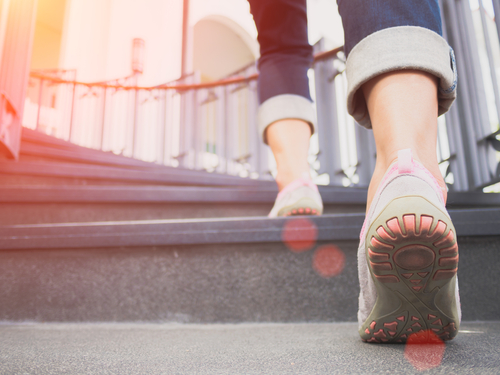#MDA2021 – Wearable Sensors Seen as Viable Measure of Function, Strength
Written by |

A higher number of daily steps, measured through wearable sensors, was associated significantly with more lower-body strength and functional abilities in adults with Charcot-Marie-Tooth (CMT) type 1 A disease, according to recent data from a pilot study.
The findings support the use of physical activity as a future outcome measure in CMT clinical trials, but further studies are needed to confirm its potential value, researchers noted.
The results were presented by Katy Eichinger, PhD, of the University of Rochester, New York, in an oral presentation titled “A Pilot Study Using A Novel Wearable Sensor to Examine Physical Activity In Individuals With Charcot Marie Tooth Disease 1A,” at the 2021 MDA Virtual Clinical and Scientific Conference, held March 15–18.
People with CMT report gait and balance difficulties, which affect their quality of life. They also have reduced physical activity, which may serve as an important measure to assess the efficacy of investigational treatments in clinical trials.
Current clinical trial measures in CMT are “subject to how a person feels and functions on any particular day, and may not reflect the true abilities of an individual,” Eichinger said.
As such, wearable sensors or devices that allow researchers and clinicians to monitor how patients are doing over time, rather than through a given day’s test, are gaining interest.
These sensors can measure the number of steps taken per day or capture the time spent in several positions, such as lying, sitting, standing and walking, “which may provide information about physical activity, especially in individuals who may be more affected by the condition,” Eichinger said.
However, it is important to clarify how these remote assessments relate to in-person clinical outcome measures, such as those gauging function and disease severity.
Eichinger and colleagues at the University of Rochester evaluated physical activity through wearable sensors in 15 adults with CMT type 1A — the most common form of the disease — and its potential links with measures of functioning and disease severity.
Participants were asked to wear BioStamp MC-10 sensors during in-person assessments of mobility and then for the subsequent 24 hours. Using adhesive pads, three of these small, soft, flexible sensors were applied at the chest, thigh, and lower leg.
After the 24-hour assessment period, the patients removed the sensors and sent them back to the team so they could analyze data regarding time spent resting, moving, and sleeping, as well as the number of steps taken.
Physical activity variables were compared to the CMT Functional Outcome Measure (CMT-FOM), which assesses hand function, balance, and mobility, as well as measures of disease severity, muscle strength, and the CMT Exam Score.
Most participants, who had a mean age of 37.3 years (range, 18–64), were women (67%) and had mostly mild disease.
Results showed that patients were active for a mean time of 150 minutes (two-and-a-half hours) and rested for a mean of 781 minutes (about 13 hours) per day. In addition, they took an average of 4,416 steps a day (range, 872 to 9,704 steps).
Notably, physical activity, as measured by the number of steps, was associated significantly with functional ability, as assessed with the CMT-FOM, and lower-body muscle strength.
“Physical activity, as measured by the number of steps taken, using adhesive wearable devices was associated with in-person measures of strength and function,” Eichinger said, adding that these wearable sensors provided a feasible way to collect physical activity data.
Among the pilot study limitations, she pointed out the small number of evaluated patients, the shorter period of remote physical activity assessment (24 hours), and the fact that steps and activity during in-person functional assessments — completed while already using the sensors — also were part of the final recorded data.
Eichinger said that future studies with a larger number of patients and involving physical activity remote assessment for longer periods of time are needed to clarify whether physical activity could be used to assess treatment efficacy in clinical trials.
“There’s lots of questions and lots of information that we need to continue to gather to better understand how to use this type of measurement for clinical trials” and interventions to improve physical activity in many neuromuscular conditions, including CMT, she concluded.
The team now is collecting data from age-matched healthy individuals to help analyze these findings and are working on ways to use wearable sensors to collect other potentially relevant physical information, such as step velocity, stride length, and balance.




